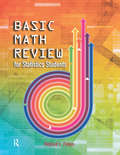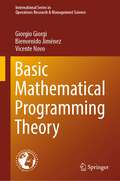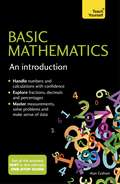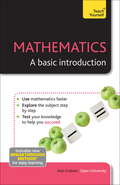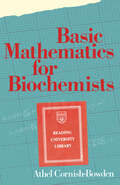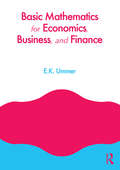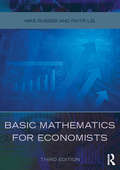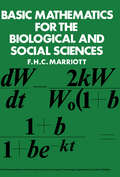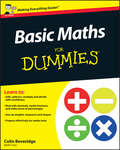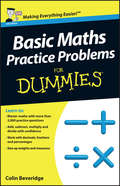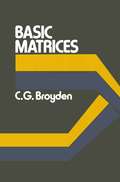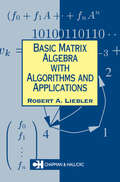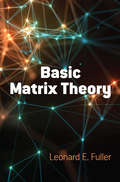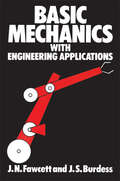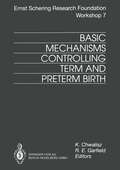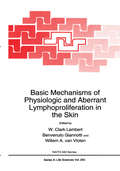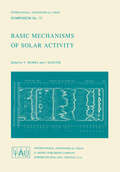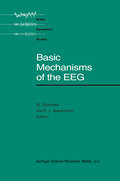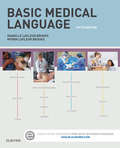- Table View
- List View
Basic Math Review: For Statistics Students
by Mildred Patten� Provides remediation for students who are rusty in their basic computational skills.� Helps break the cycle of failure leading to loss of self-confidence, which leads to more failure.� Students study six clusters of computational skills necessary for success in statistics.� With computational skills mastered, students can concentrate on more important course objectives.� Humorous cartoons interspersed throughout the book help alleviate statistics anxiety.
Basic Mathematical Programming Theory (International Series in Operations Research & Management Science #344)
by Giorgio Giorgi Bienvenido Jiménez Vicente NovoThe subject of (static) optimization, also called mathematical programming, is one of the most important and widespread branches of modern mathematics, serving as a cornerstone of such scientific subjects as economic analysis, operations research, management sciences, engineering, chemistry, physics, statistics, computer science, biology, and social sciences. This book presents a unified, progressive treatment of the basic mathematical tools of mathematical programming theory. The authors expose said tools, along with results concerning the most common mathematical programming problems formulated in a finite-dimensional setting, forming the basis for further study of the basic questions on the various algorithmic methods and the most important particular applications of mathematical programming problems. This book assumes no previous experience in optimization theory, and the treatment of the various topics is largely self-contained. Prerequisites are the basic tools of differential calculus for functions of several variables, the basic notions of topology and of linear algebra, and the basic mathematical notions and theoretical background used in analyzing optimization problems. The book is aimed at both undergraduate and postgraduate students interested in mathematical programming problems but also those professionals who use optimization methods and wish to learn the more theoretical aspects of these questions.
Basic Mathematics: Teach Yourself Ebook
by Alan GrahamBasic Mathematics teaches you all the maths you need for everyday situations. If you are terrified by maths, this is the book for you.Do you shy away from using numbers? Basic Mathematics can help. An easy-to-follow guide, it will ensure you gain the confidence you need to tackle maths and overcome your fears. It offers simple explanations of all the key areas, including decimals, percentages, measurements and graphs, and applies them to everyday situations, games and puzzles to help you understand mathematics quickly and enjoyably.Everything you need is here in this one book. Each chapter includes clear explanations, worked examples and test questions. At the end of the book there are challenges and games to give you new and interesting ways to practise your new skills.
Basic Mathematics: A bestselling introduction to mathematics for absolute beginners (Teach Yourself)
by Alan GrahamDo you shy away from using numbers? Basic Mathematics can help. An easy-to-follow guide, it will ensure you gain the confidence you need to tackle maths and overcome your fears. It offers simple explanations of all the key areas, including decimals, percentages, measurements and graphs, and applies them to everyday situations, games and puzzles to give you understanding quickly and enjoyably.NOT GOT MUCH TIME?One, five and ten-minute introductions to key principles to get you started.AUTHOR INSIGHTSLots of instant help with common problems and quick tips for success, based on the author's many years of experience.TEST YOURSELFTests in the book and online to keep track of your progress.EXTEND YOUR KNOWLEDGEExtra online articles at www.teachyourself.com to give you a richer understanding of psychology.FIVE THINGS TO REMEMBERQuick refreshers to help you remember the key facts.TRY THISInnovative exercises illustrate what you've learnt and how to use it.
Basic Mathematics for Biochemists
by A. Cornish-BowdenSome teachers of biochemistry think it positively beneficial for students to struggle with difficult mathematics. I do not number myself among these people, although I have derived much personal pleasure from the study of mathematics and from applying it to problems that interest me in biochemistry. On the contrary, I think that students choose courses in biochemistry out of interest in biochemistry and that they should not be encumbered with more mathematics than is absolutely required for a proper understanding of biochemistry. This of course includes physical chemistry, because a biochemist ignorant of physical chemistry is no biochemist. I have been guided by these beliefs in writing this book. I have laid heavy emphasis on those topics, such as the use of logarithms, that play an important role in biochemistry and often cause problems in teaching; I have ignored others, such as trigonometry, that one can manage without. The proper treatment of statistics has been more difficult to decide. Although it clearly plays an important part in all experi mental sciences, it is usually preferable to treat it as a subject in its own right and not to try to incorporate it into a course of elementary mathematics. In this book, therefore, I have used a few examples from statistics to illustrate more general points, but I have not discussed it for its own sake.
Basic Mathematics for Economics, Business and Finance
by Ek UmmerThis book can help overcome the widely observed math-phobia and math-aversion among undergraduate students in these subjects. The book can also help them understand why they have to learn different mathematical techniques, how they can be applied, and how they will equip the students in their further studies.? The book provides a thorough but lucid exposition of most of the mathematical techniques applied in the fields of economics, business and finance. The book deals with topics right from high school mathematics to relatively advanced areas of integral calculus covering in the middle the topics of linear algebra; differential calculus; classical optimization; linear and nonlinear programming; and game theory. ? Though the book directly caters to the needs of undergraduate students in economics, business and finance, graduate students in these subjects will also definitely find the book an invaluable tool as a supplementary reading. The website of the book – ww.emeacollege.ac.in/bmebf – provides supplementary materials and further readings on chapters on difference equation, differential equations, elements of Mathematica®, and graphics in Mathematica®, . It also provides materials on the applications of Mathematica®, as well as teacher and student manuals.
Basic Mathematics for Economics, Business and Finance
by EK UmmerThis book can help overcome the widely observed math-phobia and math-aversion among undergraduate students in these subjects. The book can also help them understand why they have to learn different mathematical techniques, how they can be applied, and how they will equip the students in their further studies. The book provides a thorough but lucid exposition of most of the mathematical techniques applied in the fields of economics, business and finance. The book deals with topics right from high school mathematics to relatively advanced areas of integral calculus covering in the middle the topics of linear algebra; differential calculus; classical optimization; linear and nonlinear programming; and game theory. Though the book directly caters to the needs of undergraduate students in economics, business and finance, graduate students in these subjects will also definitely find the book an invaluable tool as a supplementary reading. The website of the book – ww.emeacollege.ac.in/bmebf – provides supplementary materials and further readings on chapters on difference equation, differential equations, elements of Mathematica®, and graphics in Mathematica®, . It also provides materials on the applications of Mathematica®, as well as teacher and student manuals.
Basic Mathematics for Economists
by Piotr Lis Mike RosserBasic Mathematics for Economists, now in its 3rd edition, is a classic of its genre and this new edition builds on the success of previous editions. Suitable for students who may only have a basic mathematics background, as well as students who may have followed more advanced mathematics courses but who still want a clear explanation of fundamental concepts, this book covers all the basic tenets required for an understanding of mathematics and how it is applied in economics, finance and business. Starting with revisions of the essentials of arithmetic and algebra, students are then taken through to more advanced topics in calculus, comparative statics, dynamic analysis, and matrix algebra, with all topics explained in the context of relevant applications, New features in this third edition reflect the increased emphasis on finance in many economics and related degree courses, with fuller analysis of topics such as: savings and pension schemes, including draw down pensions asset valuation techniques for bond and share prices the application of integration to concepts in economics and finance input-output analysis, using spreadsheets to do matrix algebra calculations In developing new topics the book never loses sight of their applied context and examples are always used to help explain analysis. This book is the most logical, user-friendly book on the market and is usable for mathematics of economics, finance and business courses in all countries.
Basic Mathematics for Economists
by Piotr Lis Mike RosserBasic Mathematics for Economists, now in its 3rd edition, is a classic of its genre and this new edition builds on the success of previous editions. Suitable for students who may only have a basic mathematics background, as well as students who may have followed more advanced mathematics courses but who still want a clear explanation of fundamental concepts, this book covers all the basic tenets required for an understanding of mathematics and how it is applied in economics, finance and business. Starting with revisions of the essentials of arithmetic and algebra, students are then taken through to more advanced topics in calculus, comparative statics, dynamic analysis, and matrix algebra, with all topics explained in the context of relevant applications, New features in this third edition reflect the increased emphasis on finance in many economics and related degree courses, with fuller analysis of topics such as: savings and pension schemes, including draw down pensions asset valuation techniques for bond and share prices the application of integration to concepts in economics and finance input-output analysis, using spreadsheets to do matrix algebra calculations In developing new topics the book never loses sight of their applied context and examples are always used to help explain analysis. This book is the most logical, user-friendly book on the market and is usable for mathematics of economics, finance and business courses in all countries.
Basic Mathematics for the Biological and Social Sciences
by F. H. MarriottBasic Mathematics for the Biological and Social Sciences deals with the applications of basic mathematics in the biological and social sciences. Mathematical concepts that are discussed in this book include graphical methods, differentiation, trigonometrical or circular functions, limits and convergence, integration, vectors, and differential equations. The exponential function and related functions are also considered. This monograph is comprised of 11 chapters and begins with an overview of basic algebra, followed by an introduction to infinitesimal calculus, scalar and vector quantities, complex numbers, and the simplest types of differential equation. The use of graphs in the presentation of data is also described, along with limits and convergence, rules for differentiation, the exponential function, and maxima and minima. Techniques of integration, vectors and their derivatives, and simultaneous differential equations are explored as well. Examples from biology, economics and related subjects, probability theory, and physics are provided. This text will be a useful resource for mathematicians as well as biologists and social scientists interested in applying mathematics to their work.
Basic Maths For Dummies
by Colin BeveridgeWhether you are returning to school, studying for an adult numeracy test, helping your kids with homework, or seeking the confidence that a firm maths foundation provides in everyday encounters, Basic Maths For Dummies, UK Edition, provides the content you need to improve your basic maths skills. Based upon the Adult Numeracy Core Curriculum, this title covers such topics as: Getting started with the building blocks of maths and setting yourself up for success Dealing with decimals, percentages and tackling fractions without fear Sizing Up weights, measures, and shapes How to handle statistics and gauge probability Filled with real-world examples and written by a PhD-level mathematician who specialises in tutoring adults and students, Basic Maths For Dummies also provides practical advice on overcoming maths anxiety and a host of tips, tricks, and memory aids that make learning maths (almost) painless - and even fun.
Basic Maths For Dummies
by Colin BeveridgeWhether you are returning to school, studying for an adult numeracy test, helping your kids with homework, or seeking the confidence that a firm maths foundation provides in everyday encounters, Basic Maths For Dummies, UK Edition, provides the content you need to improve your basic maths skills. Based upon the Adult Numeracy Core Curriculum, this title covers such topics as: Getting started with the building blocks of maths and setting yourself up for success Dealing with decimals, percentages and tackling fractions without fear Sizing Up weights, measures, and shapes How to handle statistics and gauge probability Filled with real-world examples and written by a PhD-level mathematician who specialises in tutoring adults and students, Basic Maths For Dummies also provides practical advice on overcoming maths anxiety and a host of tips, tricks, and memory aids that make learning maths (almost) painless - and even fun.
Basic Maths Practice Problems For Dummies
by Colin BeveridgeLearn to: Master maths with more than 2,000 practice questions Add, subtract, multiply and divide with confidence Work with decimals, fractions and percentages Size up weights and measures Fun, friendly coaching and all the practice you need to tackle maths problems with confidence and ease In his popular Basic Maths For Dummies, professional maths tutor Colin Beveridge proved that he could turn anyone – even the most maths-phobic person – into a natural-born number cruncher. In this book he supplies more of his unique brand of maths-made-easy coaching, plus 2,000 practice problems to help you master what you learn. Whether you're prepping for a numeracy test or an employability exam, thinking of returning to school, or you'd just like to be one of those know-it-alls who says, 'Oh, that's easy!' about any maths problem that comes your way, this book is for you. Master basic arithmetic, fast – in no time, solving addition, subtraction, multiplication and division problems will seem as easy as tying your shoes Face down fractions – you'll never again feel shy around fractions, decimals, percentages and ratios Juggle weights and measures like a pro – whether it's a question of how much it weighs, how long (or far) it is, or how much it costs, you'll never be at a loss for an answer Make shapes your playthings – circles, squares, triangles and rectangles – you'll measure them, draw them and manipulate them with ease Open the book and find: 2,000 pencil-and-paper practice problems The keys to mastering addition, subtraction, multiplication and division The lowdown on fractions, decimals and percentages Basic geometry made easy How to handle weights, measures and money problems How to read charts, tables and graphs at a glance
Basic Maths Practice Problems For Dummies
by Colin BeveridgeLearn to: Master maths with more than 2,000 practice questions Add, subtract, multiply and divide with confidence Work with decimals, fractions and percentages Size up weights and measures Fun, friendly coaching and all the practice you need to tackle maths problems with confidence and ease In his popular Basic Maths For Dummies, professional maths tutor Colin Beveridge proved that he could turn anyone – even the most maths-phobic person – into a natural-born number cruncher. In this book he supplies more of his unique brand of maths-made-easy coaching, plus 2,000 practice problems to help you master what you learn. Whether you're prepping for a numeracy test or an employability exam, thinking of returning to school, or you'd just like to be one of those know-it-alls who says, 'Oh, that's easy!' about any maths problem that comes your way, this book is for you. Master basic arithmetic, fast – in no time, solving addition, subtraction, multiplication and division problems will seem as easy as tying your shoes Face down fractions – you'll never again feel shy around fractions, decimals, percentages and ratios Juggle weights and measures like a pro – whether it's a question of how much it weighs, how long (or far) it is, or how much it costs, you'll never be at a loss for an answer Make shapes your playthings – circles, squares, triangles and rectangles – you'll measure them, draw them and manipulate them with ease Open the book and find: 2,000 pencil-and-paper practice problems The keys to mastering addition, subtraction, multiplication and division The lowdown on fractions, decimals and percentages Basic geometry made easy How to handle weights, measures and money problems How to read charts, tables and graphs at a glance
Basic Matrix Algebra with Algorithms and Applications (Chapman Hall/CRC Mathematics Series)
by Robert A. LieblerClear prose, tight organization, and a wealth of examples and computational techniques make Basic Matrix Algebra with Algorithms and Applications an outstanding introduction to linear algebra. The author designed this treatment specifically for freshman majors in mathematical subjects and upper-level students in natural resources, the social sciences, business, or any discipline that eventually requires an understanding of linear models. With extreme pedagogical clarity that avoids abstraction wherever possible, the author emphasizes minimal polynomials and their computation using a Krylov algorithm. The presentation is highly visual and relies heavily on work with a graphing calculator to allow readers to focus on concepts and techniques rather than on tedious arithmetic. Supporting materials, including test preparation Maple worksheets, are available for download from the Internet.This unassuming but insightful and remarkably original treatment is organized into bite-sized, clearly stated objectives. It goes well beyond the LACSG recommendations for a first course while still implementing their philosophy and core material. Classroom tested with great success, it prepares readers well for the more advanced studies their fields ultimately will require.
Basic Matrix Algebra with Algorithms and Applications (Chapman Hall/CRC Mathematics Series)
by Robert A. LieblerClear prose, tight organization, and a wealth of examples and computational techniques make Basic Matrix Algebra with Algorithms and Applications an outstanding introduction to linear algebra. The author designed this treatment specifically for freshman majors in mathematical subjects and upper-level students in natural resources, the social sciences, business, or any discipline that eventually requires an understanding of linear models. With extreme pedagogical clarity that avoids abstraction wherever possible, the author emphasizes minimal polynomials and their computation using a Krylov algorithm. The presentation is highly visual and relies heavily on work with a graphing calculator to allow readers to focus on concepts and techniques rather than on tedious arithmetic. Supporting materials, including test preparation Maple worksheets, are available for download from the Internet.This unassuming but insightful and remarkably original treatment is organized into bite-sized, clearly stated objectives. It goes well beyond the LACSG recommendations for a first course while still implementing their philosophy and core material. Classroom tested with great success, it prepares readers well for the more advanced studies their fields ultimately will require.
Basic Matrix Theory
by Leonard E. FullerWritten as a guide to using matrices as a mathematical tool, this text is geared toward physical and social scientists, engineers, economists, and others who require a model for procedure rather than an exposition of theory. Knowledge of elementary algebra is the only mathematical prerequisite. Detailed numerical examples illustrate the treatment's focus on computational methods. The first four chapters outline the basic concepts of matrix theory. Topics include the development of the concept of elementary operations and a systematic procedure for simplifying matrices as well as a method for evaluating the determinant of a given square matrix. Subsequent chapters explore important numerical procedures, including the process for approximating characteristic roots and vectors plus direct and iterative methods for inverting matrices and solving systems of equations. Solutions to the problems are included.
Basic Mechanics with Engineering Applications
by J. Jones J. Burdess J. N. FawcettThis book gives a sufficient grounding in mechanics for engineers to tackle a significant range of problems encountered in the design and specification of simple structures and machines. It also provides an excellent background for students wishing to progress to more advanced studies in three-dimensional mechanics.
Basic Mechanics with Engineering Applications
by J. Jones J. Burdess J. N. FawcettThis book gives a sufficient grounding in mechanics for engineers to tackle a significant range of problems encountered in the design and specification of simple structures and machines. It also provides an excellent background for students wishing to progress to more advanced studies in three-dimensional mechanics.
Basic Mechanisms Controlling Term and Preterm Birth (Ernst Schering Foundation Symposium Proceedings #7)
by R. E. Garfield K. ChwaliszThe mechanisms that initiate labour (i. e. , the conversion of the quies cent uterus to an active and reactive organ at term) are poorly under stood. Of considerable importance are the factors that control preterm labour and preterm birth, with their devastating effects on society. This problem is the leading obstetrical issue. Preterm labour affects ap proximately 10% of all pregnant women (even higher numbers are re- Abb. I. The participants of the workshop VI Preface ported for less developed countries or where prenatal healthcare is a low priority) and it is the leading cause of morbidity and mortality of babies. Current practices to arrest preterm labour, once initiated, are in effective. In addition, procedures to stimulate labour and dilate the cer vix at term may not be used effectively. On October 19th - 21 st, 1992, a Schering Foundation Workshop took place in Berlin to discuss the "Basic Mechanisms Controlling Term and Preterm Labour". Leading scientists from Europe and North America were assembled to consider the fundamental systems which regulate the uterus and cervix during pregnancy. The topics in the sym posium ranged from key cellular events governing uterine contractility and cervical dilatation during labour to clinical advances and applica tions. This book contains the proceedings of the workshop. We were pleased to have been part of the workshop and to have been responsible for its organization.
Basic Mechanisms of Physiologic and Aberrant Lymphoproliferation in the Skin (Nato Science Series A: #265)
by W. Clark Lambert Benvenuto Giannotti Willem A. Van VlotenThis book is based upon a series of papers originally presented at a NATO Advanced Studies Workshop of the same title held at the study Center HI Cappuccini," a converted monastery in San Miniato, a small village located between Pisa and Florence, Italy, in October 1991. Authors were asked to submit their completed chapters by the following February; these were then scanned onto computer disks, edited and returned to the authors for final revision, and updating, with a final deadline of February 1993. The authors were encouraged to make whatever modifications they wanted, especially regarding updating their chapters, with an eye to making the final product both comprehensive and current. In this we succeeded beyond our expectations, with most chapters extensively altered and many completely re-written and significantly expanded. Thus, although the original meeting was held in 1991, the chapters in this volume may be regarded as current from at least February, 1993, with some of the final updated revisions received as late as July, 1993. This book, as agreed in our original contract, has been delivered to the publisher "camera-ready. " This means that all of the scanning, editing, proofing and typesetting were done here, by the office of the Department of Dermatology at the New Jersey Medical School. We essentially produced the book, which the publisher, for the most part, then photocopied. This has been an enormous burden, borne mainly by my colleague in this division, Robert A.
Basic Mechanisms of Solar Activity (International Astronomical Union Symposia #71)
by V. Bumba J. KleczekOur first attempt to organize a Symposium on solar activity was made at the lAO General Assembly in Brighton 1970. There, at the session of Commission 10, we proposed to organize a Symposium which would stress the observational aspects of solar activity. It was our hope that such a Symposium might stimulate studies of those important problems in solar physics which for a long time had been neglected in overall scientific discussion. Although a provisional date for the Symposium was then decided, it did not take place to avoid overlapping with other lAO activities. At the session of Commission 10 in Sydney -on the occasion of the XVth lAO General Assembly in 1973 -we repeated our proposal and forwarded the invitation of the Czechoslovak Academy of Sciences to organize the Symposium in Prague. Both were accepted. During the discussions about the programme of the Symposium -enthusiastically promoted by the late president of Commission 10, Prof. K. O. Kiepenheuer -it was decided to change slightly its subject. The theoreti cal problems were stressed and the majority of the Scientific Organizing Committee agreed not to deal with short-lived phenomena of the solar activity or with individual active regions. Symposium No. 71 was held in Prague from August 25 to August 29, 1975. Its Organizing Committee consisted of V. Bumba (Chairman), W. Deinzer, R. G. Giovanelli, R. Howard, K. O. Kiepenheuer, M. Kopecky, T. Krause, M. Kuperus, G.
Basic Mechanisms of the EEG (Brain Dynamics)
by Zschocke SpeckmannThis volume is based on selected and updated papers from the symposium on "Basic Mechanisms of the EEG," which was held under the sponsor ship of the German EEG Society in Hamburg on September 28-29, 1990. The intention of this symposium was to relate recent experimental, clini cal, and neuropathological data on the basic mechanism that underlie the EEG. Although we know much about these mechanisms, there is still much more to be learned. The symposium was partly the continuation of an earlier symposium on "Origin of Cerebral Field Potentials" held in 1979 in Munster under the leadership of one of the present editors (E. -J. Speckmann) and H. Caspers. The present work combines new experimental and clinical results with state-of-the-art reports giving excellent general views. The first chapter presents a historical survey of the roots of current developments in neu rophysiology. It seems that in the near future we may decipher the EEG, which we have considered up to now somewhat as a cryptogram (chap ter 2). After chapter 3-a chapter concerned with more general points of the generation of cortical field potentials-chapters 4, 5, and 6 deal with several aspects and models of interactions and rhythms of cortical neurons. The role of glial cells in cortical electrical field generation is considered in chapter 7. Chapter 8 emphasizes the significance of brain metabolism.
Basic Medical Language - E-Book
by Myrna LaFleur Brooks Danielle LaFleur BrooksBasic Medical Language - E-Book
